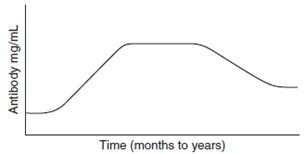Exam Details
Exam Code
:USMLE-STEP-1Exam Name
:United States Medical Licensing Step 1Certification
:USMLE CertificationsVendor
:USMLETotal Questions
:847 Q&AsLast Updated
:Apr 17, 2025
USMLE USMLE Certifications USMLE-STEP-1 Questions & Answers
-
Question 451:
A 22-year-old man complains to his family physician of fatigue, night sweats, and a dry unproductive cough. Until the past few months, he had apparently been in good health. Acomplete blood count (CBC) and differential blood count reveal that he is lymphopenic. X-ray examination reveals an interstitial pneumonia. Skin test reactions to a battery of materials are normal. Which of the following should be the next step in evaluating this patient's illness?
A. CH50 complement assay
B. chemotaxis assay
C. identification of the organism that is causing the pneumonia
D. intracellular killing assay
E. nitroblue tetrazolium reduction assay
-
Question 452:
A 25-year-old female executive presents with edema, hematuria, proteinuria, and decreased urination indicative of glomerulonephritis. Three weeks ago she had impetigo on her chest which resolved without treatment. Which of the following organisms is the most likely cause of her renal disease?
A. E. coli
B. S. aureus
C. S. saprophyticus
D. Streptococcus agalactiae
E. S. pyogenes
-
Question 453:
A 42-year-old woman had a catheter placed in her urethra. One week later she is experiencing suprapubic flank pain with urinary urgency and frequency. She has also chills and fever. After examining the patient and evaluating the sediment of her centrifuged urine, she is informed by her physician that she has acute ascending pyelonephritis. If the diagnosis is accurate and the patient's urine is cultured, which of the following organisms will most likely be isolated?
A. Clostridium difficile
B. Escherichia coli with pili
C. Pseudomonas aeruginosa
D. Staphylococcus aureus
E. streptococci--group B
-
Question 454:
While on a wilderness vacation, a banker develops extensive skin lesions noted for their varying degrees of erythema, edema, and vesiculations. His physician tells him that these lesions are due to delayed type hypersensitivity. If this is actually the case, which of the following statements is accurate?
A. Delayed-type hypersensitivity can be transferred passively to volunteers by sensitized lymphocytes.
B. Delayed-type hypersensitivity is suppressed by antihistaminic drugs.
C. This allergy does not cause tissue damage.
D. This allergy is due to IgE absorbed on mast cells.
E. This type of allergy usually occurs after inhalation of grass pollens.
-
Question 455:
A medical student has been immunized with hepatitis B virus (HBV) recombinant vaccine. The curve in below figure represents the production of protective antibodies to the viral component present in the recombinant vaccine. Which of the following is the known viral component of the HBV vaccine?

A. nucleocapsid proteins of HBV
B. RNA genome of HBV
C. viral core antigen (HBcAg)
D. viral e antigen (HBeAg)
E. viral surface antigen (HBsAg)
-
Question 456:
A 20-year-old woman with generally normal health and immune capacity visited her doctor complaining of 2 weeks of fever, sore throat, and cough. She had recently seen bloodstreaked sputum and had noticeable chest pain. X-rays showed only a moderate amount of pulmonary consolidation, while a cold agglutinin titer of 1:256 was reported. Which organism listed below is the most likely etiological agent?
A. Chlamydia pneunoniae
B. Coxiella burnetii
C. Legionella pneumophila
D. Mycoplasma pneumonia
E. Pneumocystis carinii
-
Question 457:
Which of the following can most likely restore the immunological competency of this 5-month-old baby?
A. administration of purine nucleoside phosphorylase
B. B-cell supplementation
C. compatible bone marrow transplantation
D. injection of adenosine deaminase
E. T-cell treatment
-
Question 458:
A 5-month-old baby presents to the local community clinic with noted oral candidiasis, chronic diarrhea, extensive diaper rash, and an overall failure to thrive. Previously this infant has been seen for multiple severe, recurrent infections from viruses, fungi, bacteria, and protozoa. Chest x-ray reveals an absent thymic shadow. Which of the following immunodeficiencies best explains this baby's recurrent infections?
A. Bruton agammaglobulinemia
B. deficiencies in the C5C8 components of complement
C. deficiency in neutrophil NADPH oxidase
D. DiGeorge syndrome
E. severe combined immunodeficiency (SCID)
-
Question 459:
A 45-year-old man was admitted to the hospital because of fever, shortness of breath, and weight loss with edema in the lower limbs. Examination revealed cardiomegaly and arrhythmias, and a diagnosis of myocarditis was made. Bacterial blood cultures were negative. Which of the following organisms is most likely responsible for this illness?
A. adenovirus
B. coxsackie group A virus
C. coxsackie group B virus
D. mumps virus
E. rhinovirus
-
Question 460:
A 37-year-old man was immunologically competent but presented to his physician with malaise, fever, lethargy, and back pain. Examination also revealed vertebral osteomyelitis, splenomegaly, and hepatomegaly. He was a PPD-negative farm worker who consumed unpasteurized goat milk. Which of the organisms listed below is the mostlikely etiological agent?
A. Actinomyces israelii
B. Aspergillus fumigates
C. Brucella melitensis
D. Candida albicans
E. Mycobacterium tuberculosis
Tips on How to Prepare for the Exams
Nowadays, the certification exams become more and more important and required by more and more enterprises when applying for a job. But how to prepare for the exam effectively? How to prepare for the exam in a short time with less efforts? How to get a ideal result and how to find the most reliable resources? Here on Vcedump.com, you will find all the answers. Vcedump.com provide not only USMLE exam questions, answers and explanations but also complete assistance on your exam preparation and certification application. If you are confused on your USMLE-STEP-1 exam preparations and USMLE certification application, do not hesitate to visit our Vcedump.com to find your solutions here.